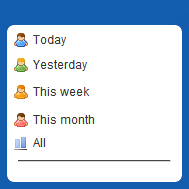Hyperparameter optimization of XGBoost using artificial bee colony for predicting medical complications in hemodialysis patients
DOI:
https://doi.org/10.21107/kursor.v13i1.459Keywords:
Artificial Bee Colony, Complications, Hemodialysis, Hyperparameter, XGBOOSTAbstract
Chronic Kidney Disease (CKD) is a serious global health issue, ranking as the 12th leading cause of death in 2019, with a 31.7% increase since 2010. Many CKD patients require hemodialysis, which poses risks of complications such as hypertension, hypotension, and gastrointestinal disorders, increasing mortality. This study predicts hemodialysis complications using XGBoost optimized with the Artificial Bee Colony (ABC) algorithm. The dataset includes numerical and categorical variables such as blood pressure, hemoglobin levels, gender, and complication history. To improve class distribution, the Synthetic Minority Over-sampling Technique is applied. Five test scenarios with different ABC parameter configurations were conducted to optimize XGBoost hyperparameters. Results indicate that balancing the dataset with SMOTE enhances model accuracy. Among the tested scenarios, Test 3, with ABC parameters n_bees set to 30, max_iter set to 30, and limit set to 10, achieved the highest accuracy, increasing from 89% (unbalanced) to 94% (balanced). Although training time increased, the improved performance highlights the potential of the XGBoost-ABC framework for early complication detection. This approach can enhance patient care, reduce mortality risks, and support clinical decision-making for hemodialysis patients.
Downloads
References
[1] N. Z. Aditama, H. Kusumajaya, and N. Fitri, “FAKTOR-FAKTOR YANG BERHUBUNGAN DENGAN KUALITAS HIDUP PASIEN GAGAL GINJAL KRONIS,” vol. 6, no. 1, 2024.
[2] Tim Penulis Kementrian Kesehatan, “Laporan Nasional Riskesdas 2018.” Badan Penelitian dan Pengembangan Kesehatan.
[3] L. ISROIN, MANAJEMEN CAIRAN PADA PASIEN HEMODIALISIS UNTUK MENINGKATKA N KUALITAS HIDUP. Unmuh Ponorogo Press, 2016. [Online]. Available: https://umpopress.umpo.ac.id/media/2024-01-18/manajemen-cairan-pada-pasien-hemodialisis-untuk-meningkatkan-kualitas-hidup/mobile/index.html
[4] Rizki Muliani, L. A. Fauziah, and Sumbara, “Komorbiditas dan Lama Menjalani Hemodialisis dengan Kualitas Hidup pada Klien yang Menjalani Hemodialisis,” Window Health J. Kesehat., pp. 533–544, May 2022, doi: 10.33096/woh.v5i02.24.
[5] T. Irr, “INDONESIAN RENAL REGISTRY 2020”.
[6] H. J. Murff, V. L. Patel, G. Hripcsak, and D. W. Bates, “Detecting adverse events for patient safety research: a review of current methodologies,” J. Biomed. Inform., vol. 36, no. 1–2, pp. 131–143, Feb. 2003, doi: 10.1016/j.jbi.2003.08.003.
[7] S. Chaudhuri et al., “Artificial intelligence enabled applications in kidney disease,” Semin. Dial., vol. 34, no. 1, pp. 5–16, Jan. 2021, doi: 10.1111/sdi.12915.
[8] F. Ratantja Kusumajati, B. Rahmat, and A. Junaidi, “IMPLEMENTATION OF BALANCING DATA METHOD USING SMOTETOMEK IN DIABETES CLASSIFICATION USING XGBOOST,” J. Ilm. Kursor, vol. 12, no. 4, pp. 201–212, Dec. 2024, doi: 10.21107/kursor.v12i4.410.
[9] F. A. Mohammad, A. M. Rizki, and A. N. Sihananto, “PERAMALAN TINGKAT INFLASI DI INDONESIA MENGGUNAKAN ARTIFICIAL BEE COLONY DAN XGBOOST,” J. Inform. Dan Tek. Elektro Terap., vol. 12, no. 3, Aug. 2024, doi: 10.23960/jitet.v12i3.4827.
[10] P. Septiana Rizky, R. Haiban Hirzi, and U. Hidayaturrohman, “Perbandingan Metode LightGBM dan XGBoost dalam Menangani Data dengan Kelas Tidak Seimbang,” J Stat. J. Ilm. Teori Dan Apl. Stat., vol. 15, no. 2, pp. 228–236, Dec. 2022, doi: 10.36456/jstat.vol15.no2.a5548.
[11] W.-H. Hsieh, C. C.-Y. Ku, H. P.-C. Hwang, M.-J. Tsai, and Z.-Z. Chen, “Model for Predicting Complications of Hemodialysis Patients Using Data From the Internet of Medical Things and Electronic Medical Records,” IEEE J. Transl. Eng. Health Med., vol. 11, pp. 375–383, 2023, doi: 10.1109/JTEHM.2023.3234207.
[12] M. Othman, A. M. Elbasha, Y. S. Naga, and N. D. Moussa, “Early prediction of hemodialysis complications employing ensemble techniques,” Biomed. Eng. OnLine, vol. 21, no. 1, p. 74, Oct. 2022, doi: 10.1186/s12938-022-01044-0.
[13] J. Dong et al., “Machine learning-based intradialytic hypotension prediction of patients undergoing hemodialysis: A multicenter retrospective study,” Comput. Methods Programs Biomed., vol. 240, p. 107698, Oct. 2023, doi: 10.1016/j.cmpb.2023.107698.
[14] K. G. Pebriantari and I. P. Astuti Dewi, “HUBUNGAN KOMPLIKASI INTRA HEMODIALISIS DENGAN KUALITAS HIDUP PADA PASIEN CHRONIC KIDNEY DISEASE (CKD) STAGE V YANG MENJALANI HEMODIALISIS DI RUANG HEMODIALISA BRSU TABANAN TAHUN 2017,” J. Ris. Kesehat. Nas., vol. 2, no. 1, pp. 9–17, Apr. 2018, doi: 10.37294/jrkn.v2i1.95.
[15] N. A. Pramudhyta and M. S. Rohman, “Perbandingan Optimasi Metode Grid Search dan Random Search dalam Algoritma XGBoost untuk Klasifikasi Stunting,” J. MEDIA Inform. BUDIDARMA, vol. 8, no. 1, p. 19, Jan. 2024, doi: 10.30865/mib.v8i1.6965.
[16] R. Basuki, Z. J. H. Tarigan, H. Siagian, L. S. Limanta, D. Setiawan, and J. Mochtar, “The effects of perceived ease of use, usefulness, enjoyment and intention to use online platforms on behavioral intention in online movie watching during the pandemic era,” Int. J. Data Netw. Sci., vol. 6, no. 1, pp. 253–262, 2022, doi: 10.5267/j.ijdns.2021.9.003.
[17] P. A. Riyantoko, T. M. Fahrudin, K. M. Hindrayani, and M. Idhom, “Exploratory Data Analysis and Machine Learning Algorithms to Classifying Stroke Disease,” IJCONSIST J., vol. 2, no. 02, pp. 77–82, Jun. 2021, doi: 10.33005/ijconsist.v2i02.49.
[18] A. T. Damaliana, T. Trimono, and D. A. Prasetya, “Ensemble Tree untuk Memprediksi Level Resiko Maternal Mortality di Bangladesh,” Pros. Semin. Nas. SAINS DATA, vol. 2, no. 1, pp. 24–29, Nov. 2022, doi: 10.33005/senada.v2i1.36.
[19] R. Luo, L. Guo, X. Li, J. Tuo, C. Lei, and Y. Zhou, “An eXtreme Gradient Boosting Algorithm Combining Artificial Bee Colony Parameters Optimized Technique for Single Sand Body Identification,” IEEE Access, vol. 9, pp. 156894–156906, 2021, doi: 10.1109/ACCESS.2021.3129830.
[20] A. T. Damaliana, A. Muhaimin, and D. A. Prasetya, “FORECASTING THE OCCUPANCY RATE OF STAR HOTELS IN BALI USING THE XGBOOST AND SVR METHODS”.
[21] A. Muhaimin, W. Wibowo, and P. A. Riyantoko, “Multi-label Classification Using Vector Generalized Additive Model via Cross-Validation,” J. Inf. Commun. Technol., vol. 22, 2023, doi: 10.32890/jict2023.22.4.5.
[22] A. Z. Nur, H. Suyono, and M. Aswin, “APPLICATION OF HYBRID GA-PSO TO IMPROVE THE PERFORMANCE OF DECISION TREE C5.0,” J. Ilm. Kursor, vol. 10, no. 4, Dec. 2020, doi: 10.21107/kursor.v10i4.248.
[23] M. Nasrudin, “MRI-Based Brain Tumor Instance Segmentation Using Mask R-CNN,” Comput. Eng. Appl. J., vol. 13, no. 03, pp. 1–9, Oct. 2024, doi: 10.18495/comengapp.v13i03.490.
[24] F. N. Riyana Putri, R. R. Isnanto, and A. Sugiharto, “SKIN RASH CLASSIFICATION SYSTEM USING MODIFIED DENSENET201 THROUGH RANDOM SEARCH FOR HYPERPARAMETER TUNING,” J. Ilm. Kursor, vol. 12, no. 4, pp. 179–190, Dec. 2024, doi: 10.21107/kursor.v12i4.418.

Downloads
Published
Issue
Section
Citation Check
License
Copyright (c) 2025 Rangga Laksana Aryananda, Trimono, Wahyu Syaifullah J, Wan Suryani Wan Awang

This work is licensed under a Creative Commons Attribution 4.0 International License.








